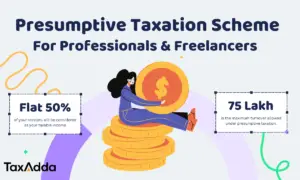Introduction
The Taxation Law (Amendment) Ordinance 2019 introduce Section 115BAB on 20th September 2019 applicable from the financial year 2019-20.
Lower Income Tax Rate
This section provides an option only to certain new domestic manufacturing companies to pay income tax at the rate of 15% (plus applicable surcharge and cess)beginning from the financial year 2019-20. The domestic company can opt for lower-income tax rate during any financial year (2019-20 or thereafter). However, the option once exercised,can not be subsequently withdrawn and shall apply to all the subsequent financial years.
Note: – Flat surcharge of 10% (irrespective of turnover) along with 4% cess is applicable to the companies opting lower tax rate under Section 115BAB.The effective tax rate is 17.16% (including surcharge and cess).
Eligibility Criteria
Any domestic manufacturing companies have an option to pay a lower income tax rate of 15% (plus applicable surcharge and cess), provided the following conditions are complied with: –
- the company has been set up and registered on or after 01st Oct 2019 and has commenced manufacturing on or before 31st Mar 2023 and
- is not formed by splitting up, or the reconstruction, of the business already in existence, provided that this condition shall not apply in respect of an undertaking which is formed under section 33B (rehabilitation allowance)
- does not use any machinery or plant previously used for any purpose provided: –
- Any machinery or plant which was used outside India by any other person shall not be regarded as machinery or plant previously used for any purpose, if the following conditions are fulfilled, namely:—such machinery or plant was not, at any time previous to the date of the installation by the person, used in India;
- such machinery or plant is imported into India from any country outside India; and
- no deduction on account of depreciation in respect of such machinery or plant has been allowed or is allowable under the provisions of this Act in computing the total income of any person for any period prior to the date of the installation of machinery or plant by the person.
- Where in the case of a person, any machinery or plant or any part thereof previously used for any purpose is put to use by the company and the total value of such machinery or plant or part thereof does not exceed twenty per cent of the total value of the machinery or plant used by the company, then, the above condition specified shall be deemed to have been complied with.
- Any machinery or plant which was used outside India by any other person shall not be regarded as machinery or plant previously used for any purpose, if the following conditions are fulfilled, namely:—such machinery or plant was not, at any time previous to the date of the installation by the person, used in India;
- does not use any building previously used as a hotel or a convention centre, as the case may be.
- “convention centre” means a building of a prescribed area comprising of convention halls to be used for the purpose of holding conferences and seminars, being of such size and number and having such other facilities and amenities, as may be prescribed;
- “hotel” means a hotel of two-star, three-star or four-star category as classified by the Central Government;
- the company is not engaged in any business other than the business of manufacture or production of any article or thing and research in relation to, or distribution of, such article or thing manufactured or produced by it; and
- the total income of the company should be computed without giving any benefits/exemptions/deductions under:-
- Section 10AA of the Act relating to unit established in Special Economic Zones (SEZ).
- Section 32(1)(iia) of the Act for additional depreciation allowance.
- Section 32AD of the Act relating to deduction for investment in new plant and machinery in notified backward area in the states of Andhra Pradesh, Bihar, Telangana and West Bengal.
- Section 33AB of the Act for tea/ coffee/ rubber development allowance.
- Section 33ABA of the Act for site restoration fund by companies engaged in the extraction of production of petroleum or natural gas or both in India.
- Section 35(1) (ii), (iia),(iii) and 35(2AA), (2AB)of the Act for certainscientific researchexpenditure.
- Section 35AD of the Act for deduction in respect of capital expenditure on specified business.
- Section 35CCC of the Act for expenditure on agricultural extension project.
- Section 35CCD of the Act for Expenditure on skill development project.
- Part Cof Chapter VIA other than section 80JJAA of the Act(deduction in respect of employment of new employees).
- Without set-off, any loss carried forward from an earlier year to the extent that such loss is attributable to any of the deduction mentioned above in point (c). However, it shall be deemed to have been already given effect to and no further deduction for such loss shall be allowed for any subsequent year.
- By claiming the depreciation, if any, under section 32, other than clause additional depreciation under section 32(1)(iia) of the Act, determined in such manner as may be prescribed. In other words, domestic manufacturing companies can claim depreciation under Section 32 but benefits for additional depreciation shall not be available.
- The option should be exercised by the domestic manufacturing companies in the prescribed manner on or before the due date specified under Section 139(1) for furnishing the return of income for any financial year i.e. usually 30th September of the assessment year.
- Provision of Section 115JB relating to MAT shall not be applicable to the domestic manufacturing companies which exercise option under Section 115BAB. It is also clarified that the tax credit of MAT paid by the domestic manufacturing company shall not be available consequent to exercising of such option.
Note: – There is no time limit for the domestic manufacturing company to opt for lower-income tax under Section 115BAB. So, the companies can opt for the benefit of Section 115BAB once they set- all the brought forward losses and MAT credit under the regular tax regime.
Applicability of Transfer Pricing Provisions
a) In a case where due to a close connection between the company and any other person, or for any other reason, the business between them is so arranged such that the company earns more than ordinary profits, the assessing officer may ignore the excess profits. The Assessing Officer will take only the amount of profits reasonably deemed to be derived from the business.
b) In a case where the business transaction involves a specified domestic transaction referred to in section 92BA, the profits of the transaction will be determined having regard to the arm’s length price.
Comparative Effective Tax Rate for Financial Year 2019-20
- The company have an income lower than Rs. 1 crore during the financial year 2019-20.
| Particulars | Opt Section 115BAB | Doesn’t Opt Section 115BAB |
| Tax Rate | 15% | 25% |
| Surcharge | 10% | NA |
| Education Cess | 4% | 4% |
| Effective Tax Rate | 17.16% | 26% |
- Company having income more than Rs. 1 crore but upto Rs. 10 crore during financial year 2019-20
| Particulars | Opt Section 115BAB | Doesn’t Opt Section 115BAB |
| Tax Rate | 15% | 25% |
| Surcharge | 10% | 7% |
| Education Cess | 4% | 4% |
| Effective Tax Rate | 17.16% | 27.82% |
- Company having income more than Rs. 10 crore during financial year 2019-20
| Particulars | Opt Section 115BAB | Doesn’t Opt Section 115BAB |
| Tax Rate | 15% | 25% |
| Surcharge | 10% | 12% |
| Education Cess | 4% | 4% |
| Effective Tax Rate | 17.16% | 29.12% |
Note: – MAT is also applicable @ 15% on the companies who does not opt Section 115BAB.
Conclusion
Government reduce the tax rate on corporates which is a welcome move to boost the economy. Whereas, on the other hand, take our the various benefits/exemption available like additional depreciation etc. Every corporate has to consider various factors before opting Section 115BAB like: –
- Balance of brought forward losses
- Available MAT credit
- Current taxable income and projected income
- Current turnover and projected turnover
- The pattern of investment in plant and machinery for additional depreciation
- MAT applicability
- Various exemption not available under Section 115BAB
- Cash flows
Let’s understand the end result of a company with a simple example. Assuming a domestic company having a total income of Rs 20 lakh during the financial year 2019-20. His tax liability shall be as follow: –
| Particulars | Opt Section 115BAB | Doesn’t Opt Section 115BAB |
| Total Income | 20,00,000 | 20,00,000 |
| Tax Rate | 15% | 25% |
| Tax Amount | 3,00,000 | 5,00,000 |
| Add: Surcharge (10%) | 30,000 | NA |
| Tax After Surcharge | 3,30,000 | 5,00,000 |
| Add: 4% Cess | 13,200 | 20,000 |
| Total Tax Liability | 3,43,200 | 5,20,000 |
| Saving/Loss | 1,76,800 | – |
In the above example, if we assume that the company made an investment in plant and machinery of Rs. 50 lakh during the financial year 2019-20 then the tax calculation will be as follows: –
| Particulars | Opt Section 115BAB | Doesn’t Opt Section 115BAA |
| Total Income | 20,00,000 | 20,00,000 |
| Less: Additional depreciation under section 32(1)(iia) @ 20% | – | 10,00,000 |
| Total Income | 20,00,000 | 10,00,000 |
| Tax Rate | 15% | 25% |
| Tax Amount | 3,00,000 | 2,50,000 |
| Add: Surcharge (10%) | 30,000 | NA |
| Tax After Surcharge | 3,30,000 | 2,50,000 |
| Add: 4% Cess | 13,200 | 10,000 |
| Total Tax Liability | 3,43,200 | 2,60,000 |
| Saving/Loss | (83,200) | – |
The end result will be different for each and every corporate as you can see in the above example. It’s a one-way road, you can opt Section 115BAB any time but there is no way to opt-out.

